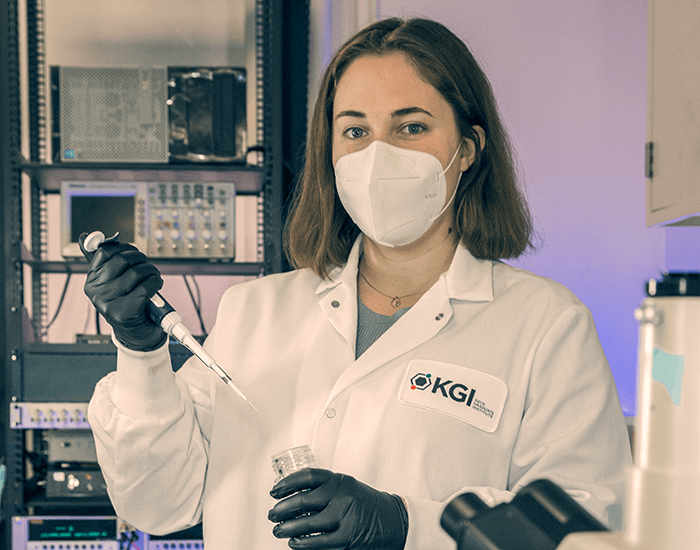Written by Sarah Balderston, a KGI Research Associate, Cardea Bio Scientist, and incoming PhD student at Caltech.
When I began my undergraduate degree at Scripps College, I was certain that I wanted to be a medical doctor.
I knew biology had been my favorite subject in school throughout the years, and I wanted to continue to study science critical to human health. However, at the time, I had a limited imagination of the potential career paths I could carve for myself beyond medicine. It was not until I began looking for research opportunities to help with my medical school applications that I started to consider research a viable career path. It took some time to find a lab with space and the resources to take me on as a student, which I remember being a pretty discouraging experience.
One day, I received a department-wide email from a faculty member at Keck Graduate Institute (KGI). It was an invitation to apply to join Dr. Kiana Aran's new biomedical device lab. I remember being somewhat intimidated after my first Google search of Dr. Aran. She was experienced in electrical and biomedical engineering and microfluidic platforms, all of which were new topics for me. Despite my unsophisticated knowledge of these disciplines, I applied, interviewed, and was selected by Dr. Aran to join her lab.
I worked in the Aran Lab for the remainder of my undergraduate degree, including participating in the Summer Undergraduate Research Experience (SURE) program at KGI the summer before my senior year. Not only was I introduced to biosensing technology and CRISPR, but also research as a discipline. I learned that scientific research could be extraordinarily challenging. You constantly have to solve and maneuver unexpected obstacles, and successes can often feel like they are too few and far between. Still, the longer I worked in the Aran Lab, the more I realized that I thoroughly enjoyed the pursuit. When it came time to dedicate more time in my schedule to medical school applications, I realized that I would much rather be in the lab, so there I stayed.
My undergraduate work in the Aran Lab focused on developing a CRISPR-based DNA detection assay, which was employed to validate a CRISPR protein's biological function when covalently bound to a surface. This project was how I became involved in CRISPR electronics. Instead of attaching the CRISPR protein to the surface of microparticles, I graduated to immobilizing the protein to the graphene biosensor's surface to enable digital and sequence-specific DNA detection without amplification. I continued to contribute to this project after graduating from Scripps College in 2018. That summer, we began testing this platform with clinical samples and hypothesized that the CRISPR-based biosensor could discriminate between DNA samples from patients with different Duchenne muscular dystrophy-associated mutations depending on the design of the gRNA employed in the CRISPR construct. We found that this technology, CRISPR-Chip, could identify specific deletion mutations implicated in DMD pathology. In March 2019, we published this study in Nature Biomedical Engineering.
Soon after publishing, we began working on expanding the potential applications of CRISPR-Chip technology by optimizing the platform to detect single nucleotide mutations (SNPs) implicated in sickle cell disease (SCD) and amyotrophic lateral sclerosis (ALS). This optimization included working with biosensing experts to expand the electrical measurements taken and incorporating novel CRISPR enzymes to improve sensor specificity. Our team was recently able to share our work on CRISPR-SNP-Chip after publication in the most recent issue of Nature Biomedical Engineering.
Besides the academic achievements that I was able to be a part of over the past three years, my experience in the Aran Lab has also provided me with a personal and professional development level that I did not get from my undergraduate coursework. When I first began working with Dr. Aran, I was timid. I didn’t have much confidence in myself or my ideas. I have since evolved from a student who awaited directions from a more experienced person to an independent scientist. This internal transition has demonstrated just how fun science can be. For example, the other day, I was driving home while listening to a podcast. One of the interviewers mentioned something that flipped a switch in my mind. I promptly pulled over to text Dr. Aran and bug her about purchasing the materials and dedicating the resources to peruse a new project.
Through Dr. Aran’s connections to both academic and industry collaborators, I have also been able to get involved in many business and project planning meetings with both industry and academic collaborators. My experience in the Aran Lab has helped me hone my hard research skills and my “soft” interpersonal skills necessary for effective teamwork, leadership, and self-confidence. In addition to immersing myself in the novel field of CRISPR-electronics, I have learned how to maneuver both personal and professional obstacles, take advantage of the opportunities available to me, and be a more independent and critical thinker.
In the fall, I will begin a PhD program in bioengineering at Caltech, where I hope to continue working with CRISPR technology to contribute meaningful work in cancer research. I am not sure this opportunity would have been possible if I had not responded to that one email in 2017 that brought me to the Aran Lab at KGI. If I had any advice to offer current students, it would be to get out there and get after it, whatever that means to you.
